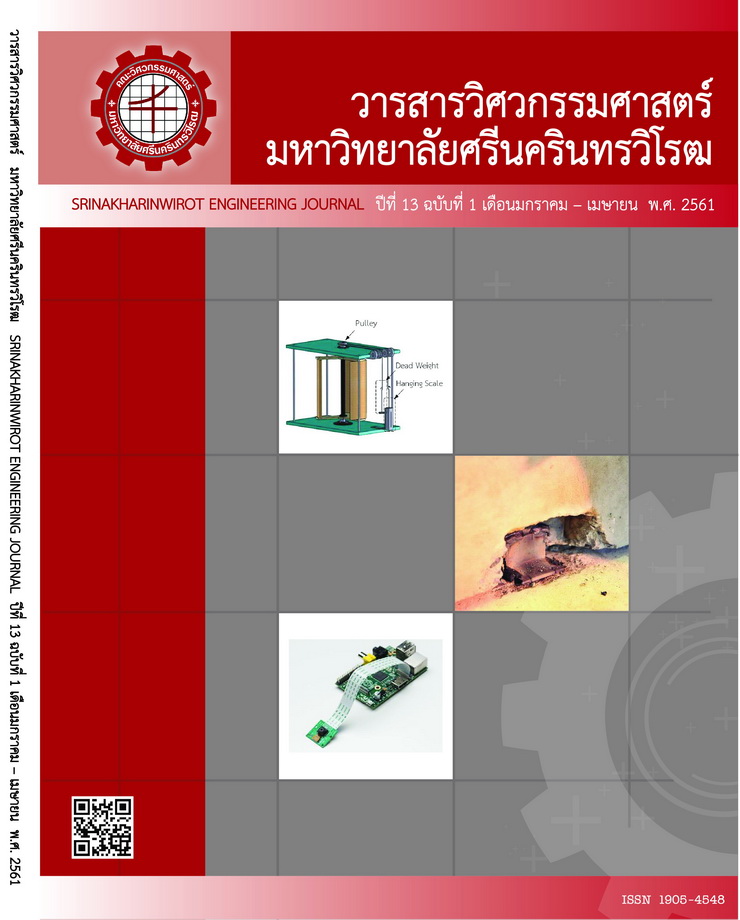Mechanical and Physical Properties of Thermoplastic Natural Rubber Composites Reinforced with Rubberwood Sawdust
Main Article Content
Abstract
This research aimed to investigate mechanical and physical properties of thermoplastic natural rubber composites reinforced with rubberwood sawdust, affecting from plastic types, wood sawdust contents and coupling agent contents. In manufacturing the composites, a twin-screw extruder was applied to blend mixture components. The composite pellets were then molded in a compression molding machine as composite panels. From results of experiment, two-way analysis of variance (ANOVA) indicated that the wood sawdust contents and coupling agent contents significantly (P-value < 0.05) affected tensile strength, modulus of rupture, modulus of elasticity, compressive strength and modulus, hardness, water absorption and thickness swelling. Increasing additions of wood sawdust from 30 wt% to 50 wt% into the composites resulting in the tensile strength, tensile strain and modulus of rupture decreased, but tensile modulus, modulus of elasticity, compressive modulus, hardness, water absorption and thickness swelling increased. Likewise, additions of coupling agent both maleic anhydride-grafted polyethylene and maleic anhydride-grafted polypropylene positively improved the mechanical and physical properties of the composites. However, the addition of too much coupling agent reduced the mechanical properties. The optimal coupling agent found was 4 wt% for the tensile strength, compressive strength, water absorption and thickness swelling. Furthermore, the composites with polypropylene and wood sawdust showed clearly higher tensile, flexural, compressive and hardness properties than the composites with high-density polyethylene and wood sawdust, when compared to the same composition rate.
Article Details
Copyright belongs to Srinakharinwirot University Engineering Journal
References
[2] M. S. Jamil, I. Ahmad, and I. Abdullah, “Effects of rice husk filler on the mechanical and thermal properties of liquid natural rubber compatibilized high-density polyethylene/ natural rubber blends,” J. Polym. Res., vol. 13, no. 4, pp. 315-321, 2006.
[3] D. S. Campbell, D. J. Elliott, and M. A. Wheelans, “Thermoplastic natural rubber blends,” NR Technol., vol. 9, no. 21, pp. 29-37, 1978.
[4] N. R. Legge, G. Holden, and H. E. Schroeder, Thermoplastic elastomers: a comprehensive review. Hanser Publishers: New York, 1987.
[5] K. Kosonmetee, “Preparation and mechanical properties of rubber composites made from thermoplastic natural rubber blended with jute fiber,” M.S. thesis, Dept. Mater. Sci. Technol., Prince of Songkla Univ., Songkhla, Thailand, 2009.
[6] M. A. López-Manchado and M. Arroyo, “Effect of the incorporation of pet fibers on the properties of thermoplastic elastomer based on PP/elastomer blends,” Polym., vol. 42, no. 15, pp. 6557-6563, 2001.
[7] W. N. W. Busu, H. Anuar, S. H. Ahmad, R. Rasid, and N. A. Jamal, “The mechanical and physical properties of thermoplastic natural rubber hybrid composites reinforced with Hibiscus cannabinus, L and short glass fiber,” Polym. Plas. Technol. Eng., vol. 49, no. 13, pp. 1315-1322, 2010.
[8] H. Anuar and A. Zuraida, “Improvement in mechanical properties of reinforced thermoplastic elastomer composite with kenaf bast fibre,” Compos. B: Eng., vol. 42, no. 3, pp. 462-465, 2011.
[9] Z. H. Xu and Z. N. Kong, “Mechanical and thermal properties of short-coir-fiber-reinforced natural rubber/polyethylene composites,” Mec. Compos. Mater., vol. 50, no. 3, pp. 353-358, 2014.
[10] M. R. M. Piah, A. Baharum, and I. Abdullah, “Mechanical properties of bio-composite natural rubber/high density polyethylene/ mengkuang fiber,” Polym. Polym. Compos., vol. 24, no. 9, pp. 767-774, 2016.
[11] Y. A. El-Shekeil, S. M. Sapuan, K. Abdan, and E. S. Zainudin, “Influence of fiber content on the mechanical and thermal properties of Kenaf fiber reinforced thermoplastic polyurethane composites,” Mater. Des., vol. 40, pp. 299-303, Sep. 2012.
[12] A. Ashori, “Wood–plastic composites as promising green-composites for automotive industries!,” Biores. Technol., vol. 99, no. 11, pp. 4661-4667, 2008.
[13] C. Homkhiew, “Development and applications of natural fiber/thermoplastic composites for industrial,” J. Indus. Technol., vol. 10, no. 2, pp. 97-110, 2014.
[14] M. A. S. Spinace, K. K. G. Fermoseli, and M. A. D. Paoli, “Recycled polypropylene reinforced with curaua fibers by extrusion,” J. Appl. Polym. Sci., vol. 112, no. 6, pp. 3686-3694, 2009.
[15] S. Mohanty, S. K. Verma, S. K. Nayak, and S. S. Tripathy, “Influence of fiber treatment on the performance of sisal-polypropylene composites,” J. Appl. Polym. Sci., vol. 94, no. 3, pp. 1336-1345, 2004.
[16] C. Homkhiew, T. Ratanawilai, and W. Thongruang, “Composites from recycled polypropylene and rubberwood flour: Effects of composition on mechanical properties,” J. Thermoplas. Compos. Mater., vol. 28, no. 2, pp. 179-194, 2015.
[17] D. Ndiaye, L. M. Matuana, S. M. Therias, L. Vidal, A. Tidjani, and J. L. Gardette, “Thermal and mechanical properties of polypropylene/ wood-flour composites,” J. Appl. Polym. Sci., vol. 119, no. 6, pp. 3321-3328, 2011.
[18] T. Ratanawilai, N. Thanawattanasirikul, and C. Homkhiew, “Mechanical and thermal properties of oil palm wood sawdust reinforced post-consumer polyethylene composites,” ScienceAsia, vol. 38, no. 3, pp. 289-294, 2012.
[19] M. R. Rahman, M. M. Huque, M. N. Islam, and M. Hasan, “Improvement of physico-mechanical properties of jute fiber reinforced polypropylene composites by post-treatment,” Compos. A: Appl. Sci. Manufac., vol. 39, no. 11, pp. 1739-1747, 2008.
[20] P. Y. Kuo, S. Y. Wang, J. H. Chen, H. C. Hsueh, and M. J. Tsai, “Effects of material compositions on the mechanical properties of wood–plastic composites manufactured by injection molding,” Mater. Des., vol. 30, no. 9, pp. 3489-3496, 2009.
[21] B. Kord, “Effect of wood flour content on the hardness and water uptake of thermoplastic polymer composites,” World Appl. Sci. J., vol. 12, no. 9, pp. 1632-1634, 2011.
[22] A. Ashori and S. Sheshmani, “Hybrid composites made from recycled materials: Moisture absorption and thickness swelling behavior,” Biores. Technol., vol. 101, no. 12, pp. 4717-4720, 2010.
[23] C. Homkhiew, “Factors affecting water absorption behavior of wood-plastic composites,” J. Indus. Technol., vol. 11, no. 2, pp. 94-111, 2015.
[24] A. A. Klyosov, Wood-Plastic Composites. New Jersey, John Wiley & Son Inc., 2007.
[25] S. Tamrakar and R. A. Lopez-Anido, “Water absorption of wood polypropylene composite sheet piles and its influence on mechanical properties,” Construc. Build. Mater., vol. 25, no. 10, pp. 3977-3988, 2011


